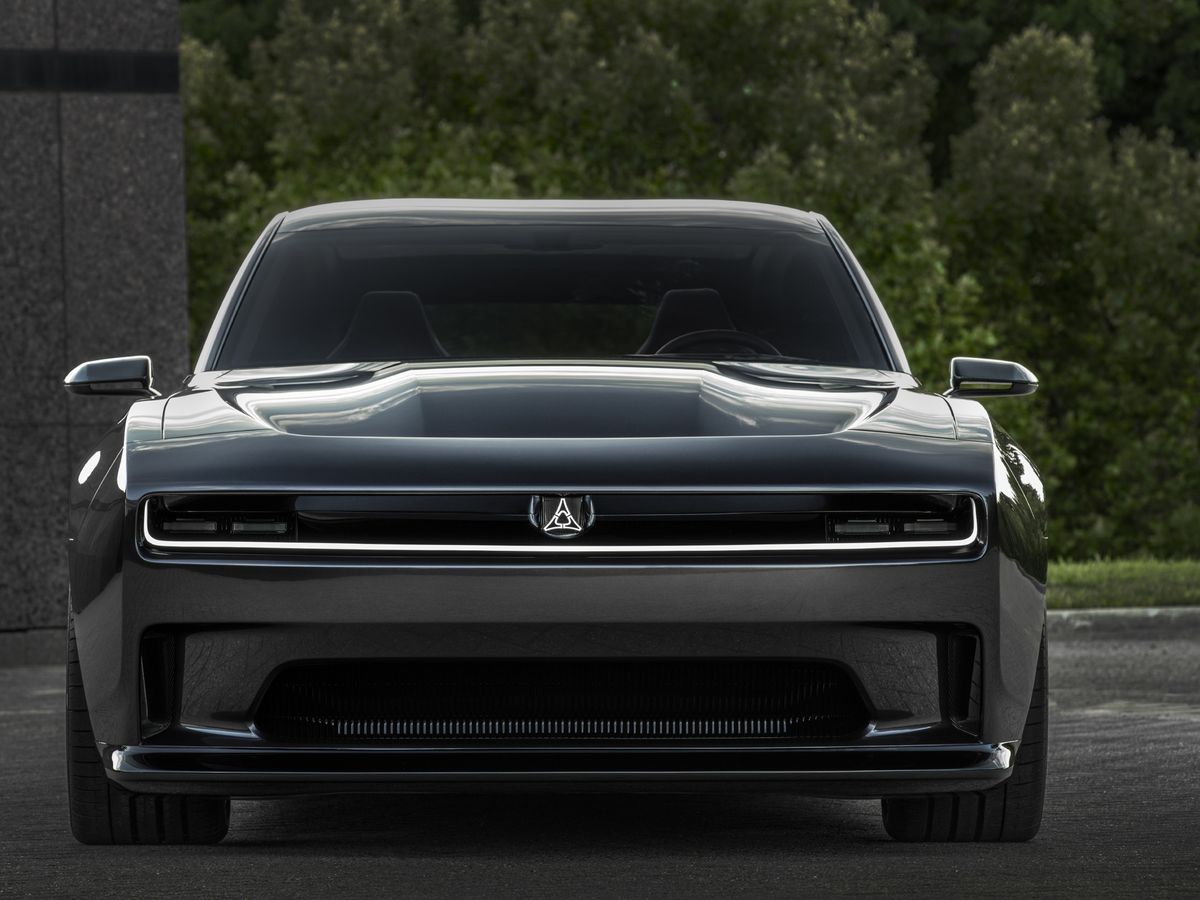Business
Dodge Muscle Cars Live On With New Versions Of The Charger Powered By Electricity Or Gasoline

DETROIT — America’s muscle car culture will endure while the country shifts to electric vehicles, but the gas-powered performance automobile will be there for at least a few more years.
On Tuesday, Dodge debuted two battery-powered Charger muscle cars that still roar like a large V8 engine but emit no pollution from the tailpipe.
New iterations of the Charger that run on gasoline or electricity continue to be Dodge muscle cars.
However, the Stellantis brand, which has carved out a market niche for high-performance vehicles, will continue selling a gas-powered Charger without the large Hemi V8.
Both will be based on Stellantis’ worldwide large vehicle platform, and the Windsor, Ontario, factory that will produce them will be able to switch between gasoline and electric power depending on market demand. Stellantis’ flexibility will allow it to hedge its bets on whether electric vehicle sales take off or slow.
Last year, Stellantis discontinued production of the gas-powered Chargers and Challengers, and many believed it would be the end of the thundering sedans.
However, Dodge CEO Tim Kuniskis hinted that a gasoline version would continue to exist. “It was always there.” It was always in the plans. “It was always coming,” he explained.
Dodge Muscle Cars Live On With New Versions Of The Charger Powered By Electricity Or Gasoline
However, the business downplayed the gas version in favour of two- and four-door electric variants that resemble Chargers from the 1960s, with aerodynamic lines and hatchbacks rather than trunks.
The electric versions, branded Charger Daytona after the NASCAR raceway in Florida, will have two powertrains, one with up to 670 horsepower and the ability to accelerate from 0 to 60 mph (97 km/h) in 3.3 seconds. The other is no slouch, with 496 horsepower and a zero to 60 time of 4.7 seconds.
Dodge boasts that its high-performance electric version is the world’s fastest and most powerful muscle car. Next year, an even higher-performing version will be released.
The 496-horsepower Daytona is predicted to have a range of 317 miles (510 kilometres) per charge, while the high-performance version can travel 260 miles (418 kilometres).
Both will include the company’s Fratzonic Chambered Exhaust, which routes air through a chamber to replicate the roar of a V8.
Both are hefty because of their large batteries, with gross vehicle weights of more than three tons.
The new gas-powered Charger Sixpack will have a similar design to the electric variants and be powered by a new 3-litre six-cylinder engine with two turbochargers. Standard variants will generate 420 horsepower, while high-output engines will produce 550.
According to the firm, the new engine will produce more horsepower and torque than the previous 5.7- and 6.4-liter Hemi V8s. According to company executives, fuel efficiency tests on the Charger’s new engine still need to be finished.
Dodge Muscle Cars Live On With New Versions Of The Charger Powered By Electricity Or Gasoline
All variants have all-wheel drive, although they can be converted to rear-wheel drive, so owners may still experience burnout and drift. There will be alternatives to prepare the automobiles for the racecourse.
The two-door coupe Daytona models are anticipated to go into production this summer, while the electric four-door and gas-powered versions will begin early next year.
Kuniskis said he is still determining which kind will sell better, electric or gas. With federal tax breaks on electric vehicles, leasing payments are anticipated to be quite appealing, which could convince some consumers, he added.
Environmentalists will almost definitely attack the firm for releasing EVs that prioritize performance efficiency while maintaining the gas-powered muscle car. However, Kuniskis stated that in typical circumstances, approximately 17 million new vehicles are sold annually in the United States.
“It’s a 17 million unit industry,” he said. “And you know what? People require options,” he added, adding that the corporation could face criticism if it did not produce electrified versions.
SOURCE – (AP)
Business
Chinese Automaker BYD Slams Reports That Factory Conditions Are Poor In Brazil

(VOR News) – BYD, the Chinese manufacturer, has released a statement addressing concerns concerning adverse conditions at a construction site in Brazil where the business is building a facility.
The assertion claims that the accusations aim to “discredit” China and its enterprises. At the week’s outset, a task force led by Brazilian prosecutors declared the rescue of 163 Chinese people subjected to conditions akin to slavery at the location.
The Labor Prosecutor’s Office recorded a video of the workers’ dormitories, which displayed beds lacking mattresses and rudimentary kitchen facilities.
BYD spokeswoman Li Yunfei strongly opposed the issue on Weibo.
The statement additionally condemned the media’s portrayal of the incident. “The statement indicated that foreign entities are intentionally maligning Chinese brands, disparaging China, and seeking to jeopardize the relationship between China and Brazil.”
BYD, an acronym for “Build Your Dreams,” is a prominent maker of electric automobiles globally. On Monday evening, the corporation declared its intention to “immediately terminate the contract” with the Jinjiang Group, the contractor responsible for the factory’s construction, and stated that it was “evaluating other suitable measures…”
BYD announced that the employees at Jinjiang will be accommodated in nearby hotels temporarily and that they will not suffer negative consequences from the decision to halt operations at their workplace.
The corporation announced that it had been altering the working conditions at the construction site in recent weeks and had notified its contractors that “adjustments” were necessary.
Li’s tweet on Weibo included what it said to be a “declaration” from the Chinese workers at the site. The tweet included a video depicting individuals seated together in a room. The men’s thumbprints were crimson.
The video depicted a worker articulating a statement asserting that allegations of impoverished and “slave-like” conditions violated their human rights and that these difficulties stemmed from misunderstandings.
BYD should continue our employment here.”
Upon completing his work, the employees applauded. Prosecutors asserted that the sanitation conditions at BYD’s site were notably inadequate. There was one toilet for every 31 workers, necessitating their rise at four in the morning to line up and be prepared for work by five thirty.
Brazilian law defines conditions akin to slavery as defined by the worker’s subjugation to coerced labor or excessive working hours, acceptance of deplorable working conditions, and limitations on the worker’s freedom of movement.
Brazilian officials reported that Jinjiang Construction Brazil confiscated the workers’ passports and retained sixty percent of their wages, in addition to the substandard living conditions imposed on the workers.
The labor office’s statement indicates that employees who resign must reimburse the corporation for their travel expenses to China and return ticket costs.
The employees’ statement indicates that the passports were taken to enable the corporation to file work permits and other procedures that the employees could not accomplish independently due to language barriers.
Jinjiang Construction Brazil has reported that it is undergoing “frequent and intensive inspections by the BYD local labor department in Brazil.”
The labor department’s disclosed information was characterized as false, particularly the claims that the Jinjiang laborers were ‘enslaved’ and ‘rescued,’ which are entirely contradictory to the facts. This arose from cultural disparities, BYD translation difficulties, and comprehension difficulties regarding the content.
A declaration was issued asserting that the staff were enthusiastic about engaging with the media on the topic.
In numerous regions of the developing globe, the living conditions of migrant construction workers might be exceedingly inadequate. Moreover, such labor occasionally entails contracts that compel workers to reimburse BYD substantial sums of money expended to secure their positions, despite legal prohibitions against such agreements.
SOURCE: AP
SEE ALSO:
Naked Wines Issues 2024 Performance Review
Walmart Charged With Unlawfully Establishing Bank Accounts for 1 Million Drivers
Business
Walmart Charged With Unlawfully Establishing Bank Accounts for 1 Million Drivers

(VOR News) – The Consumer Financial Protection Bureau (CFPB) filed a lawsuit against Walmart and a fintech company called Branch Messenger, alleging that the two companies forced more than a million delivery workers to use costly bank accounts to receive their paychecks. Both of these companies were the targets of the lawsuit.
According to the action filed by the Consumer Financial Protection Bureau (CFPB), Walmart and Branch are accused of opening deposit accounts for Walmart’s Spark Drivers, who are considered independent contractors, without first getting their consent.
These bank accounts contained drivers’ personal data, including their Social Security numbers.
The lawsuit specifically claims that Walmart’s drivers, who are in charge of delivering goods from the company’s warehouses to consumers, are only allowed to have their earnings transferred into these branch accounts.
This goes against the company’s rules, which permit them to move their earnings to different accounts.
Walmart reportedly told employees in 2021 that using these accounts may lead to firing.
Additionally, the lawsuit claimed that accessing profits through the accounts was a “complex process,” typically causing weeks-long delays. Among the other accusations that were made was this one.
This was the predicament they ultimately found themselves in, even though the business had assured them that they would have prompt access to funds.
To make matters worse, according to the Consumer Financial Protection Bureau (CFPB), drivers allegedly paid ten million dollars in “junk fees” to move their earnings to different bank accounts.
Director of the Consumer Financial Protection Bureau (CFPB), Rohit Chopra, said, “Companies cannot force workers into getting paid through accounts that drain their earnings with junk fees,” in his criticism of the practice. “Junk fees are a waste of money.”
This case’s next section outlined the traits of the average Spark Driver: “in addition to being a woman, having children, not having a college degree, and having a low income.”
Walmart denied the accusations made by the Consumer Financial Protection Bureau (CFPB) and stated in a statement that it will firmly defend itself in court.
Walmart released a statement claiming that the Consumer Financial Protection Bureau’s (CFPB) hurried lawsuit is full of factual errors, exaggerations, and blatant misrepresentations of basic legal principles.
The Consumer Financial Protection Bureau (CFPB) never gave Walmart a chance to make its case in an unbiased way throughout its rushed probe. In contrast to the Consumer Financial Protection Bureau, we are ready to fiercely defend the Company before a court that respects the due process of law principle.
Additionally, Branch was charged by the Consumer Financial Protection Bureau (CFPB) with engaging in deceptive advertising and neglecting to look into and address issues pertaining to the accounts. In addition to earlier accusations, these were also made.
In contrast, Branch denied the accusations and defended its services, saying, “The Consumer Financial Protection Bureau rushed to file a lawsuit despite the company’s extensive cooperation with its investigation, refusing to engage with Branch in any meaningful way about this matter.”
Branch responded to the Walmart accusations with a statement.
Furthermore, Branch claimed that the case was motivated more by a desire for “media attention” than by concerns for the welfare of the employees. This is what he stated in his statement.
This case, which is part of a larger campaign to give these gig workers more rights, targets these individuals who work for firms like Uber, Lyft, and DoorDash who are supposed to be independent contractors. It is considered that gig workers are independent contractors.
Earlier this month, the Consumer Financial Protection Bureau (CFPB) made claims against large financial firms, including Wells Fargo, Bank of America, and JPMorgan Chase.
According to the CFPB, these organizations did not stop fraud on the money-sending app Zelle, which is a platform that lets people send and receive money.
The choice of a new director may have an impact on the outcome of this lawsuit because President-elect Donald Trump is expected to choose a replacement for the present director of the Consumer Financial Protection Bureau (CFPB).
When Jaret Seiberg was employed as a financial services policy analyst at TD Cowen Washington Research Group, she noted that the new director’s strategy for handling such matters would be the deciding element in the case’s future course.
SOURCE: TN
SEE ALSO:
Deal With Mexican Retailer, Nordstrom’s Founding Family Takes Nordstrom Private.
Sonic the Hedgehog Dominates Christmas Wish Lists
Business
Naked Wines Issues 2024 Performance Review

Naked Wines, an online retailer, has issued a performance review after announcing that sales declined 15% in the first half of the year to $112.3 million, despite management insisting it is in “a better position, both financially and strategically”.
Rodrigo Maza, who became CEO in February after joining the company as UK managing director in September 2023, stated that the company was in a better financial and strategic position, with “robust financial foundations” and committed and engaged members.
“Our strategic initiatives centred around customer acquisition and retention are generating learnings, and we are currently experiencing solid trading during the peak season period,” he told shareholders.
It also stated that a performance review is under underway in order to “proactively evaluate options to maximise shareholder value”. The end of the fiscal year will see the release of a report.
Naked Wines New CEO
He also welcomed new CFO Dominic Neary, who joined Naked Wines from Mind Gym in November, saying he was excited to collaborate with him “as we focus the business on cash, profitability, and growth with its rose wine and dry white wine.”A performance review is presently ongoing to “proactively evaluate options to maximise shareholder value,” according to the results, with a report expected to be released at the end of the fiscal year.
It also stated that it has continued to liquidate surplus inventory, with the UK and Australia returning to normal inventory levels, however US inventories remained “significantly” in excess, albeit being down $20.5 million from HY24.
It stated that it was “currently investigating options to reduce inventory levels more quickly,” which would help drive improved cash over the next two fiscal years, but “could lead to increased liquidation costs and result in EBIT at the lower end of guidance.”
Although active members (those with Angel or Wine Genie membership) declined 12% in the last 12 months, the statement noted retention of its ‘core’ members (those who had been customers for two years or more) was up two percentage points to 79%, and they remained “highly engaged”.
Customers’ total probability to refer the company to a friend (net promoter score) increased from 73 to 76 in the previous quarter, according to the report.
Turning Things Around
In August, the company reported a pre-tax loss of $16.3 million for the fiscal year ending 1 April 2024, up from $15 million in the fiscal year 2022/2023, with revenues down 18% to $290 million and repeat business down a quarter to $65 million.
Founder Rowan Gormley, on the other hand, asserted that the company was “making real progress in turning things around with its rose wine and dry white wine”.
It came after the engagement of debt consultants in March 2024 to look into refinancing possibilities and a possible wine company reorganization after the value of Naked Wines shares fell by about a third in the previous year.
Gormley increased his interest in Naked Wines significantly in December 2023, purchasing $9,600 in shares.
This was Gormley’s second round of stock purchases; he and other senior board members purchased a large number of shares in early November following a drop in share value after the firm stated it was lowering its full-year sales estimates to -12% to -16%.
Three of the company’s leaders at the time put a total of $94,000 in its stock.
Related News:
Brad Pitt And Angelina Jolie’s Winery Court Battle Heats Up
-
News4 weeks ago
Nolinor Boeing 737 Crash Lands in Montreal
-
News3 weeks ago
“Shocking Video” Vancouver Police Shoot Armed Suspect 10 Times
-
Tech4 weeks ago
Canadian Media Firms Are Suing OpenAI in a Potential Billion-Dollar Dispute.
-
Finance3 weeks ago
Chrystia Freeland Promises Mini-Budget By Dec 16th
-
News4 weeks ago
Trudeau Heads to Mar-a-Lago to Meet With President-Elect Trump
-
Tech2 weeks ago
Facebook Owner Fined 251 Million Euros For a Data Leak In 2018.


























